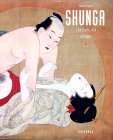Pink Glossary
Read a pink glossary of sex and the sex industry in Japan.
AIDS
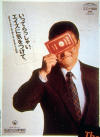
The good news is that the rate of AIDS and HIV infection in Japan is low compared with most other countries. In 2003 there were only 627 reported new cases of HIV contraction. The bad news is that while for the past 10 years the rate of infection has been going down in every other industrialized nation, in Japan the rate has continued to rise, causing some experts to predict a coming AIDS “explosion”. The problem seems to be caused by a low level of AIDS awareness in Japan where it is considered a “foreigners’ disease” and it is thus believed that one is safe unless one has intercourse with a foreigner.
AV
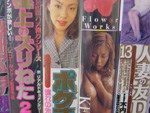
AV stands for Adult Video, i.e. pornographic movies. AV is a huge business in Japan, with about 1000 companies producing more than 30 new titles, both legal and illegal, each day! AV is easily available in Japan, and there are even vending machines for them on the street, although as a nod to the protection of minors the display is covered with a photo-sensitive material to black it out during the daylight hours. In fact AV has quite high public exposure in Japan, with AV actresses regularly appearing on TV and in magazines, and having their own websites and fanzines. There are even schools where aspiring actors and actresses can be taught the necessary skills to succeed in the business, but although good money can be made as an AV star, a typical career will last only 1 or 2 years. The predominant skills needed by AV actresses are extreme youth, an aura of innocence and sexual inexperience, and the knack of enthusiastic compliance with the instructions and desires of the men. Older, more sexually experienced, actresses are rare. Many videos will spend the first half of the movie with the young actress fully clothed, being interviewed by the (always older) male. Her innocence and inexperience firmly established, she will then be seduced by him. In the final consummation, her eyes will remain closed, and rather than moaning and groaning, she will emit whines and squeaks, rather like the sounds of a young puppy. Legal and illegal AV differs little in content, but in legal AV genitalia and pubic hair are censored by mosaic pixelation. In Japan, genitals are considered pornographic, but pedophilia and violent rape are not.
BUKKAKE
Many words from Japanese culture have entered the English language: origami, karaoke and sushi, being some of the more well established ones, with anime and manga fast becoming mainstream. One of the newest words is bukkake. Bukkake is a sexual fetish originating within the Japanese pink industry of the late 1980s that has now spread worldwide. It involves a large group of men, sometimes as many as 200, ejaculating over a woman victim/target. As with any fetish, there are numerous variations with their own terminology, such as Snowball, Dream Shower, or Bukkake Summit, but the common element in all of them involves large groups of men ejaculating on women.
By the way, if you happen to find Bukkake Soup on a restaurant menu in Japan, don’t be horrified. The word bukkake is similar in meaning to “splash”, and Bukkake Soup is one in which the liquid and vegetables have been “splashed” together quickly, implying a fresh, quickly prepared soup. There is no implication of any “special sauce”.
BURUSERA
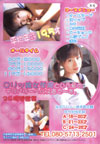
Burusera is derived from the English words “bloomers” (burumazu) and “sailor suit” (serasuutsu), and refers to the massive obsession in Japan with schoolgirls and panties. The trade in used schoolgirlwear includes whole uniforms, gym shorts, etc, but by far the most popular item is used, and preferably soiled, panties. Of course, there are no Trade Description Acts covering this trade, so there is no guarantee that the items bought have not been produced by a grandma in Yokohama with a box full of panties and a tub of yoghurt, but most sales include a photo of the schoolgirl along with the panties. For those who are more particular, many of the establishments selling the panties will have the schoolgirls themselves available. The customer chooses his girl, who then enters a booth with a glass partition, removes the panties in view of the customer, and then slips them through a slot in the partition. But the most infamous sales method by far is by vending machine. A few years ago the vending machines in Tokyo were shut down by using an obscure antiques law, but other cities have not passed such a law, so the vending machines still exist. Tokyo introduced new laws to protect minors, so the trade in panties of under 18-year-olds is outlawed, but the market is so big and well established that the trade has simply moved underground. A quick check on Yahoo Japan’s internet auction site brought up 400 pages of used underwear for sale.
CHIKAN
The word chikan means “pervert”, but it is usually only applied to men who molest and grope women in public. Japan’s commuter trains and subways are notoriously overcrowded during rush hour, and this affords the perfect environment for the chikan to operate. Groping on the trains is a huge problem in Japan. Last year there were more than 2000 arrests for it, but this is most likely just the tip of the iceberg as it is estimated that a mere 2% of victims report being molested. Surveys suggest that most young women who ride the trains during rush hour have been molested at least once. The situation is so bad that many railway companies now provide Women Only carriages on rush hour trains. According to self-confessed chikan, there are basically two types, the “orthodox” — who is excited by the look of disgust and fear on the victims face, and the “technician” whose aim is to sexually excite and titillate his victim. Most chikan fall into the former category. Though punishments for the crime are increasing and a few victims are starting to resist and fight back, it remains to be seen whether groping on trains will disappear or even decrease. However, an increasingly popular segment of the sex industry is filled by “Image Clubs” where in a simulated train carriage, the patrons are free to molest the hostesses at will. May this mean less groping on real trains?
Related words:
chijo, the female equivalent of chikan, but instances of females groping men are rare.
chikan-gari (chikan hunting), whereby a group of schoolgirls will entrap or falsely accuse a commuter of groping in order to extort money from him.
chikan-fure, meaning “chikan friends”, where a group of chikan will simultaneously descend on a victim. According to the Osaka police, this is on the increase.
DELIVERY HEALTH
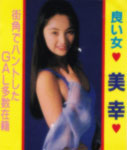
Delivery Health, or deriheru in Japanese shorthand, translates to sex delivery service or, in more polite words, escort service. It is a legal prostitution service in Japan. Escort agencies advertise their services via flyers, porn mag ads, calling cards stacked in phone booths or, today the most common and effective way, on the internet. Call the agency and arrange with the phone operator an escort visiting you at your home, your hotel or in a love hotel. Specify which girl or what type of girl you want, what type of service and the length of the girl’s visit. Prices vary by a wide margin depending on the agency, the type of escort, the type of service you request and by the length of time you book her. Legally, an escort is not allowed to engage in full intercourse. Aside from that, pretty much anything is on offer. Options might be somewhat limited by your location (the escorts don’t do long commutes) and your language abilities. If you speak flawless Japanese, you have access to the full range on offer out there. If you speak little or no Japanese, you will have only the option to deal with agencies specializing in foreign customers. When the escort arrives, pay up front before the service delivery starts. Usually, you will be asked to take a shower first before any action can start. The working girls are usually part-time freelancers though career prostitutes also work in the field.
ENJO KOSAI
Japan is a land full of euphemisms. One of my favorites is enjo kosai, which translated literally means “compensated dating”. What it really means is schoolgirl prostitution. It doesn’t refer to the under-age girls working in the sex or pornography industries; there are plenty of young runaways who find their way to working as sex-workers, and it is not unheard of for loan sharks to force their debtors to have their daughters turn tricks to pay off the debt, what enjo kosai refers to is free-lance, amateur prostitution by junior high, and high school girls. Media interest in enjo kosai peaked in the 1980’s, the height of the economic bubble, and the materialism that flourished in Japan at that time is blamed for the lax morality of these schoolgirls, for while Japan has a long history of young girls entering prostitution, traditionally this was done to support their poor families, whereas today’s schoolgirls choose paid sex to enable the purchasing of designer and brand name goods. The exact number of girls practicing enjo kosai is hard to fix, media scare stories of the eighties gave the impression that every other girl was doing it, but a reasonable estimate would be 5%. That figure would still mean the equivalent of every classroom having a teenage prostitute. Indicative of Japan’s morality and materialism, one survey of 14 and 15-year-old girls found that 20% of them saw nothing wrong or immoral in enjo kosai. Shibuya, an area of Tokyo, is renowned as a place where middle-aged men visit to “date” schoolgirls, but the preferred method of meeting is through internet dating sites and cell-phones. A new law was passed recently making it illegal to solicit anyone under 18 for sex, and convictions have increased slightly since then, notably of policemen and schoolteachers, but Japanese men have a firmly established Lolita Complex, so enjo kosai is unlikely to disappear or even diminish. The term JK business with JK standing for joshi kosei (female school student) is another similar term.
FASHION-HEALTH
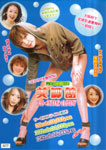
In the 1980’s a new type of sex business began to take prominence and eat into the Soaplands’ share of the lucrative sex-market. Fashion-Health Massage, or Health for short, now comprises about one third of the market, and gets around the anti-prostitution law by offering a multitude of services that all stop short of traditional ‘sexual intercourse’. The major service is oral sex, but as the menus in front of the parlors attest, a dazzling array of variations is possible, with some parlors specializing in anal sex. With prices starting at $60 for 40 minutes, but averaging about $100, the parlors are well within the price range of the average salaryman. Since the mid 90s Health Delivery services have become even more popular, and it is estimated that more than 5000 of these businesses now exist. Health Delivery is basically a Call Girl service, you phone the company, request the kind of woman you want, and a taxi delivers her to your home or, more probably, a Love Hotel. The price is 2-3 times that of a visit to a parlor, but “full service” is one of the options. Flyers advertising the delivery service can be found covering telephone boxes and telegraph poles in the entertainment districts, and it’s not uncommon to find them in your mailbox.
GAY MANGA
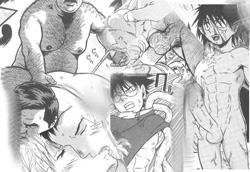
Explicitly erotic art has a long history in Japan in the form of shunga, a category of ukiyoe (floating world) woodblock prints. Shunga, originally from China, became popular in Japan in the Heian era. Shunga (春画) literally means spring picture, the season of spring being traditionally (and understandably) associated with things plumping, warming, firming, and moistening up, i.e. with things erotic.
The best of the ukiyoe artists produced shunga, probably as much for the financial rewards as anything else. Besides being sexually explicit, shunga have always been notable for frequently dealing with the quirkier side of sexuality, the most famous example being the 19th century Hokusai‘s Tako to ama Octopi and Female Diver (usually mistranslated into English as The Dream of the Fisherman’s Wife.) It depicts a woman amid the waves having cunnilingus performed on her by one octopus and being kissed, and a nipple caressed, by another, in the slithery and suckered embrace of no less than 16 serpentine arms.
While not considered particularly quirky in pre-modern Japan, homosexuality is another theme that is amply dealt with in shunga — mainly male-on-male — as well as masturbation.
Against this historical backdrop of explicit, exaggerated, unconventional (to the Western viewer) depictions of sex enters the modern manga, or comic. Read more about gay manga …
GRAVIA
Gravia is non hard-core titillation by young usually large-breasted models in bikinis or underwear. Gravia has become a massive business and as the models can be promoted by the mainstream media, gravia idols appear in magazines, on TV, DVDs, newspapers and online. “Kyo-nyu Aidoru” (Big Bust Idols) are particularly in demand.
HAMEDORI
With the ubiquitous prevalence of camera-equipped cell-phones, hamedori or the filming or photographing of sex is on the rise in Japan. According to a recent magazine poll, about one-third of Japanese women are interested in being captured in flagrante delicto. Hamedori also refers to a genre of Japanese AV where the action is shot by the male participant in sexual acts.
HAPPENING BARS & SWINGERS BARS
The Japanese consumer has an insatiable thirst for the new. If it’s new, they want it. For example, every year each of the major breweries market several new brands of beer that are indistinguishable from last years brand. And they sell. Consumers of the sex industry are not immune to this trend, with ever-more specialized forms of establishment catering to their desires being marketed. One of the latest types of establishment is the Happening Bar. Similar in most ways to Swingers Bars, which have been around a lot longer, the only difference being that Happenings Bars will allow in single people while Swingers Bars only allow in couples. There are reputed to be about 40 such clubs in Tokyo, about evenly split between Happening and Swingers. After paying a hefty membership fee followed by an entrance fee (females only pay a nominal fee) you enter a bar area. What happens next is up to you and the other patrons who are present. Maybe you try on one of the many costumes that may be available, or join a group in one of the smaller semi-private rooms, but the general rule seems to be anything goes, with S&M being fairly popular. Obviously, in such a public space it attracts many of those with a voyeuristic or exhibitionistic bent. Happening Bars made the news in the summer of 2005 when Japan’s most famous male porno star, Chocoball, (so named for the color of a certain part of his anatomy, was arrested in one for indecent exposure. He had made the mistake of advertising on his website that he would be performing, and the police had to act in the face of such a breach of the unwritten code that protects illegal sex businesses from police scrutiny. For more on Chocoball read Speed Tribes by Karl Taro Greenfeld.
HENTAI
Hentai, often reduced to simply “H” (pronounced “ecchi” in Japanese), is a Japanese word meaning perverted or perversion, but is most commonly used outside of Japan to refer to pornographic animated cartoons — Hentai Anime. Pornographic animation is not unique to Japan, Robert Crumb’s Fritz The Cat movies of the early 1970s predate what are recognized to be the first Hentai animes in Japan (Lolita Anime I and Cream Lemon, both of 1984) but Hentai Anime is yet another of Japan’s cultural exports that has established itself outside Japan and is estimated to be worth 20 million dollars in sales in the U.S. alone. The story lines in H Anime cover a range as broad as in mainstream anime, and include fantasy, science fiction, ninja, crime, black magic, the dramas of adolescence, and even, surprisingly perhaps, romance. The pornographic content varies from just a few scenes of sexuality that complement the storyline, to almost non-stop sex with no pretensions to story line at all. As with other forms of pornography and erotica in Japan, graphic depictions of extremely violent rape and domination are not at all uncommon, though not as widespread as is often reported in western media. Two sub-genres of H anime are Yaoi — male homosexuality and Yuri — female homosexulaity. The characters in H Anime are almost invariably young, and in the case of the girls, extremely young, and when they are represented, adults are often Chikan (molesters) or teachers, and often one and the same. Being cartoons, there is a wide latitude in representing the characters without the limitations of reality i.e. the laws of gravity, so the girls all have extremely large breasts — often perfectly spherical — very long legs, and extremely short skirts allowing for plenty of the obligatory panty-shots. The boys are similarly endowed with enlarged biological features. Mention must be made of a unique feature of some H anime, and that is “tentacle rape” wherein the female victim is simultaneously raped by a monster with multiple tentacles (and sometimes robotic appendages). Seen by many as a device to get around Japan’s laws prohibiting depiction of sexual organs, in fact is more likely to be derived from early Shunga, as tentacled creatures have appeared in Japanese erotica long before animated pornography appeared; among the most famous of the early instances (and perhaps the first) is a Hokusai woodcut called The Dream of the Fisherman’s Wife, depicting a woman entwined and sexually molested by a pair of octopuses.
HENTAI GAMES
Hentai Games are interactive computer games with the same style and content as Hentai Anime. Although Hentai games have begun to gain popularity in the West, and more and more are being translated into English, they do not begin to approach the level of popularity enjoyed in Japan where many games sell more than a million copies. The aim of most games is to have as much sex as possible, preferably with as many girls as possible. Violent rape and the deflowering of virgins are particularly popular strategies, and just about any perversions imaginable have games devoted to them, as well as perversions you may not yet have been able to imagine. In Japan H games are known as Bishoujo games, bishoujo meaning pretty young girl. Another type of bishoujo game that has made almost no impact in the west is ren’ai games, which are basically dating simulations. Ren’ai means romantic love, and though sex may occasionally appear it is not central to the game. Boy pursuing Girl is the most prevalent, with Girl pursuing Boy not far behind. There are even Boy meets Boy games and Girl meets Girl. Bishoujo games are the most popular form of computer games in Japan with about 50 new titles being released each month.
IMAGE CLUBS

Ime-kura (from imeji=image and kurabu=club) are a recent development and can be considered as upscale fashion-health parlors. The difference is that each room is decorated according to one of a number of themes: office, doctor’s surgery, etc. By far the most popular are the classroom and the train carriage. The “masseur” is dressed in the appropriate costume, the first most requested being the sailor suit worn by schoolgirls, with OL (office lady) uniforms coming a close second, and nurse and policewoman also being popular. This is sexual fantasy role-play taken to its logical conclusion. There is even a “Take-out” service where the girl, dressed as an OL or schoolgirl, will accompany the customer on a public train and allow him to grope her.
KISS

In some countries of the world, notably France, you see it everywhere. Everybody is doing it. Parents do it to their children and also to each other. Women do it to women, and men to men. Even politicians do it publicly. In Japan on the other hand, it is rarely done in public, and if it is it is likely to be met with disapproval or even outrage. What we are talking about here is kissing, something that many cultures consider to be an expression of friendship and affection, whereas in Japan it has primarily only one connotation sex! Kissing in Japan is part of foreplay, and therefore should only take place in private. In fact public kissing was made illegal in the 1920’s and the law was not rescinded until the occupation of 1945. Many Japanese consider kissing to be an import from the West, but an examination of shunga (Edo period pornographic prints) reveals plenty of images of couples kissing during and prior to the act of sex. However with the increasing popularity of Western-style weddings in Japan, it is becoming more common for the groom to kiss the bride at the end of the ceremony, but the tradition of other male members of the wedding party kissing the bride has not taken hold at all. In the movies kissing is no longer edited out; prior to 1945 kissing scenes in imported Hollywood movies ended up on the cutting room floor, and the first kiss in a Japanese movie, in the 1946 movie Hatachi no Seishun, caused a sensation in the press not dissimilar to the recent hullabaloo in the U.S. over Janet Jackson’s prime-time nipple exposure. In fact, the nipple-incident would not have raised an eyebrow in pre-war Japan. When it was proposed in 1930 to exhibit Rodin’s celebrated sculpture The Kiss in Tokyo, the authorities had no problem with the nudity of the figures, but insisted that the heads be covered up. The French refused at that time, but now The Kiss is on display at the Museum of Western Art in Tokyo with no covering up at all. So, things have changed, but still there remains the idea that kissing is not really Japanese, as evidenced by the fact that while the Japanese language has a word for kiss, seppun, it is rarely used, the English derived word kissu being preferred as by using a foreign word it somehow sanitizes and distances the act from what is truly Japanese.
LOLICON
Lolicon, or Roricon, is the Japanese term for Lolita Complex, and refers to older men’s attraction to very young girls. While it is certainly not a purely Japanese phenomenon, the term comes after all from Nabokov’s novel, it seems to be particularly widespread in Japan, with one survey in Tokyo finding that 75% of high school AND junior high school girls have experienced sexual solicitation by middle-aged men. Nothing symbolizes lolicon more than the Japanese schoolgirl, in her sailor suit uniform and short skirt, vast sections of the sex and pornography industry are devoted to satisfying lolicon. There is even a subculture of women called Kogal who continue to dress in school uniforms even though they have already left school, in some cases many years before. Japanese women tend to explain lolicon by attributing it to Japanese men’s inability to deal with the new generation of independent, thinking women, but there is also an element of the worship of the innocence of youth in Japanese society that applies to both sexes and results in a culture of “cute”. Whereas in western cultures teenage girls are in a hurry to “grow up” and dress and act as if they were older, in Japan the opposite is true, with many women in their twenties taking on the appearance and mannerisms of teenage girls. There is however a growing trend towards the fetishization of pre-teen girls in ero-manga, hentai, and hentai games. The consumers for these products tend to be in their twenties and belong to the group known as otaku (nerds or geeks) and computer stores and fairs are beginning to look like porno stores.
LOVE HOTELS
The words ‘love’ and ‘hotel’ combined in the English language conjure up romantic images of energetic weekends away, breakfast in bed, walks in the woods, dinner by candlelight with champagne — and whatever else springs to mind — by an open fire. In Japan, however, the resultant image of the same combination of words is somewhat different. The services offered by a ‘love-hotel’ result from necessity.
With a population of around twice that of the UK in a similar land-size, 85% of which is mountainous, space is at a premium. Also, until recently, most people lived with their families until marriage, often with three generations under one roof, separated by only paper screens. Without a private space for the most private of acts, the streets wouldn’t be a decent place to walk.
Often located near train stations or on out-of-town intersections, love hotels provide rooms by the hour, usually up to three hours for “rest” or for overnight stays. Theme rooms catering to various fantasies, including SM are common in more upmarket establishments, as is outlandish exterior architecture, though city center love hotels tend to be more discreet in appearance.
Interaction with staff behind frosted glass is kept to a minimum with guests often choosing a room from photographs by pushing a button on a panel.
PINK INDUSTRY
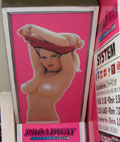
In Japan things of a sexual nature are associated with the color pink, rather than the ‘blue’ used in the West. The Pink Industry, sometimes known as the ‘Ejaculation Industry’, is Japan’s sex industry, and is huge by any standard. Estimates as to its economic size vary wildly, but 20 billion U.S. dollars p.a. is the average. If Japan’s sex industry was a country, it would have the world’s 60th largest economy. Surveys suggest that half of all Japanese men have paid for sex, and 10% patronize the Pink Industry regularly. For men in their 20s, that figure jumps to 20%. There seems to be no difficulty finding women to work in the pink establishments either. There are 3 weekly papers comprised solely of want-ads for sex workers, and numerous “alibi” businesses that provide a cover for sex-workers who wish to hide their vocation from family and friends. One news magazine extrapolated that one in sixteen women between the ages of 20 and 24 work in the industry, and while this figure may have been calculated for its sensation value, it compares with official government statistics from 1929 that counted one in every thirty women between the ages of 18 and 29 as licensed prostitutes. Japan has a long history of legal licensed prostitution, predating even the famed pleasure quarter of Yoshiwara in old Edo, but in 1956 (on April 1st, which may be significant) prostitution was made illegal. However, for the purpose of the law, sex is defined quite narrowly as the conjoining of genitals, which means that manual sex, oral sex, even anal sex, are not covered. Incidentally, a woman paying a man for sex is not illegal either. Despite the anti-prostitution law, brothels still operate openly. In Tobita, an area of Osaka not marked on English-language maps, 100 traditional brothels still operate, but most sex businesses now are called Soaplands, Fashion-Health massage parlors, Pink Salons, or Image Clubs and may be found in any town.
PINK SALONS
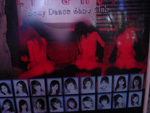
Pink Salons are at the bottom end of the price range for sex establishments in Japan, with prices being typically $60-80, but sometimes as low as $40 for a 30 minute “play”. A Pink Salon is typically just one large room, like a bar or coffee shop, usually dimly lit, with a series of sofas and sometimes booths with partitions. After choosing your course from a menu, a girl (or sequence of girls if that is the course you chose) will come to your booth and “play”. Oral sex is the norm, although, as with other pink establishments, it has been known for the girls to break the law. The male member is usually “cleaned” with a moist towel — an oshibori — and the ejaculate is not usually swallowed. The girl then leaves to wash and brush up before attending to the next client.
SEX MUSEUM
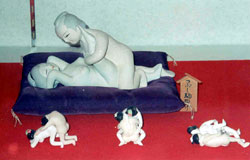
Things are never as they seem in Japan. People so coy and innocent about some things, such as revealing whether or not they have a partner, will shock you in the next breath by telling you about their recent trip to a sex museum.
Sex museums, like love hotels and porn vending machines are a staple attraction in Japan, although they exist in far fewer numbers. Sex Museum is hihokan in Japanese, and they appear all over the three islands from ‘Beppu Hihokan’ in Oita-ken, Kyushu, in the south to ‘Hokkaido Hihokan’ near Sapporo in the far north. Read more …
SHIOFUKI
Shiofuki is the Japanese term for female ejaculation, or, in its more prosaic English rendering, squirting.
The word’s original meaning, blowing salt, refers to the action of a whale surfacing and blowing out excess water. This spouting is similar, say those in the Japanese AV industry, to a woman ejaculating.
The word has gained fairly widespread use in Japan thanks to Taka Kato, a veteran porn actor who is famous for making his partners ejaculate in films.
A well-known sex expert in Japan, Dr. Kunio Kiyamura, has described shiofuki as being kind of like blocking a running hose and then relieving the pressure and watching the water spurt forth.
SHITAGIBUNKA

As well as the various fetishes men have for women’s underwear, women themselves are involved quite deeply in shitagibunka, translated as “lingerie culture”, with women’s magazines regularly running features on what is the sexiest underwear to buy. Both panties and bras come in a staggering range of colors and patterns, often more decorative than outer wear. Triumph International, Japan’s second largest lingerie company, well known for producing novelty lingerie, recently introduced a bra that gives off a fragrance supposedly helping the wearer to quit smoking, but perhaps the strangest is the Armageddon bra, introduced in the run up to Y2K. This bra came equipped with a sensor that would supposedly forewarn the wearer of any objects falling from the sky.
It is rare however to find Japanese women modeling lingerie. Most of the ads use Western women as models. This could be because the Western woman is considered the epitomy of beauty in Japan, or because, in general, Japanese women consider it brazen to show underwear in public. Most older Japanese women are extremely embarrassed if just their bra-strap is showing. However, many younger Japanese women have no such qualms and misebura (derived from (miseruburaja- lit. “showing brassiere”) has become a recent fad.
Almost all women in Japan wear bras, and the notion of removing bras as a form of liberation has never taken hold.
Shitagibunka has even spread to women’s feet, with much of the latest footwear made from the same materials as, and being similar in design to, conventional lingerie.
SHITAGIDOROBO
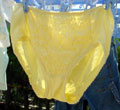
Shitagidorobo are men who steal women’s underwear from clothes lines or sometimes laundromats. (Shitagi=underwear, dorobo=thief). Underwear theft is not particular to Japan, but is widespread. In an informal survey of this writer’s wife and all his Japanese women acquaintances, every single one had had underwear stolen from her washing line, and a cover that shields the drying undies from view is in fairly common use. Like other fetishes in Japan, there are plenty of newsletters and websites for aficionados, and men’s magazines regularly include contributions from shitagidorobo. Incidentally, white seems to be the preferred color. Perhaps the most inventive method for procuring panties is that of an unknown dorobo in Osaka who phoned women posing as a local Health Official warning them of an outbreak of e.coli and asking them to immediately take off the panties they are wearing, put them in a plastic bag and deliver them to a local park. A few years ago a government official in Tokyo was caught with over 400 pairs of undies which he claims he “found on the street”. But that pales in comparison to a 55-year-old man in western Japan who was caught with more than 4,000 pairs in his apartment.
SHUNGA
Shunga is the erotic art and pornography of the Edo period (17th-19th centuries) — sometimes paintings, but more usually woodblock prints. The prints were particularly cheap — often less than the cost of a bowl of noodles — and far less than the services on offer in the pleasure quarters. For this reason they were very popular with the predominantly male population of the cities. The prints were, however, quite beautiful, and were produced by all of the major artists of the period, most notably Hokusai who is probably the most well-known such Japanese artist. Although now freely available, shunga was made illegal in the Meiji period as the government feared it would offend the Christian sensibilities of the increasing number of foreigners entering Japan.
SOAPLAND
When prostitution was made illegal in 1956, the brothels closed down and promptly re-opened as Toruko (from Turkish Bath). Following a complaint from the then Turkish Ambassador to Japan, the name was changed to Soapland, and is usually abbreviated to simply Soap. On entering a Soapland, you pay up front for an “assisted bath”. Following the bath you then pay your naked “assistant” directly for further services, including full intercourse. Because you pay the woman directly, this is seen to be a transaction between two consenting adults, therefore not illegal.
Soapland workers have the reputation of being the most beautiful and most skilled, but since the 1980s the number of Soaplands has decreased to an estimated 1200, due largely to the high cost, typically $500 for full service.
UPSKIRT
Upskirt (transliterated as appu-sukaato) is the photographing of unsuspecting women by pointing a camera up the skirt to view their underwear. Escalators, stairs, crowded trains and stores are some of the favorite haunts of the upskirt photographer who typically uses miniature cameras concealed in shoes or bags. The manager of a store selling miniature cameras in Tokyo says most customers are “men in their 20s and 30s, salarymen types.” However, since the boom in cell phones incorporating cameras, hardly a week goes by without newspaper reports of arrests of policemen, schoolteachers, university professors, civil servants, and other “respectable” members of society for the crime of upskirt photography. In fact, such was the explosion of “upskirt” crimes immediately after the launch of the camera-equipped phones that legislation was passed making it mandatory for such phones to make a loud camera-shutter sound in an attempt to make such photography less surreptitious. There are several theories for the Japanese male’s obsession with women’s panties, but the most likely explanation is that the underwear acts as a substitute for women’s genitals. Genitalia are considered obscene in Japanese law, so legal “erotic” photography features lots of panty shots. Panchira (“panty glimpse”) is a related term from the world of Japanese anime and manga.
YELLOW CABS
Yellow Cab Girls was a term coined by a Japanese journalist (male) in the 1980s to refer to the increasing number of young Japanese women who, with large disposable incomes from the economic bubble, traveled to foreign locations, notably New York City, and engaged in promiscuous sex with Western men. Yellow Cabs referred to the notion that “anyone can ride them”. The term degenerated to mean any Japanese women who engaged in casual sex with Western men. The term has now been supplanted by Roppongi girls, Roppongi being an area of Tokyo with many nightclubs and discos frequented by Western men and Japanese women seeking each other’s company.
YOBAI lit. NIGHT CREEPING
Before the advent of Love Hotels, Karaoke Boxes, personal vehicles, and other such sites of sexual liaison, a young man would have little choice but to visit the bedroom of his lover in a practice known as Yobai. Yobai meant silently creeping around the village in the still of the night, carefully and quietly sliding open the door of the young woman’s bedroom (urinating along the bottom of the door is said to have stopped it from squeaking), and then slipping under the covers for a night of passion until at the first cocks crowing, once more creeping through the village back to home. Of course it was usually an open secret, but maintaining appearances was, and is, extremely important in Japan. After marriage Yobai would continue for three more nights and on the third morning the girl’s family would discover the young couple in bed together, thereby cementing the union. During Yobai it could sometimes be very useful to be naked. In Fukuoka there was a law on the books that made it illegal to cut with a sword a naked man you found in your house. The logic being that a naked man was engaged in yobai, but a clothed man was probably a thief and it was perfectly legal to use a sword on him. Of course, if it was the wife who had been visited, then profuse and fervent apologies accompanied by a sizable gift of sake would usually be enough to smooth the situation over. A second type of Yobai was practiced in the rural regions of Western Japan after the rice had been harvested in the autumn. All the young men of the village would gather together at the headman’s house and after consuming plenty of sake would en masse make the rounds of the village. At each house where a young woman lived, the men would play janken, the Japanese version of paper, rock, scissors, and the winner would enter the house and spend the night with the girl. In the cities of Japan, where most Japanese now live, there is still speculation whether Yobai has completely disappeared in the more remote parts of Japan, though this probably represents wishful thinking on their part.
